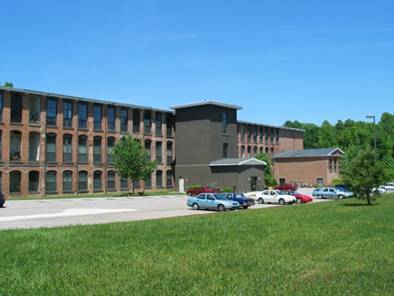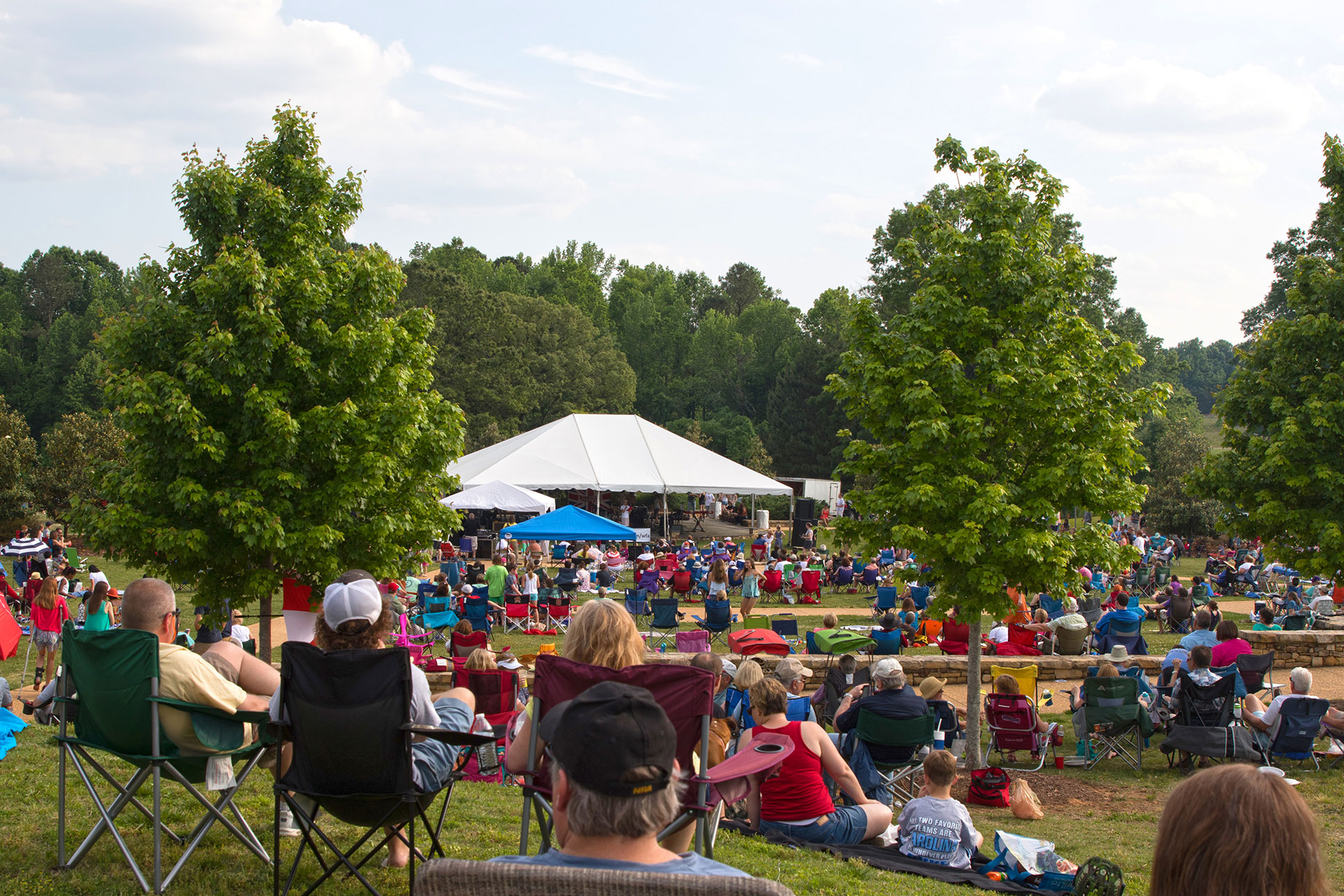History of Wake Forest
The Beginning
Wake Forest was born as a college town and for more than a century the Town and the college grew up together with intertwined histories. The original 1830's campus has changed owners and names, but remains a geographical focus of the community that has grown around it.
In 1805 this part of Wake County was designated as the "Forest District", largely for the widespread forest in the area north of the Neuse River, comprised largely of hardwoods but some softwoods including longleaf pine. The area was also sometimes referred to as the "Forest of Wake". Development began in 1820 when Dr. Calvin Jones from New England bought 615 acres in "Wake Forest Township" from Davis Battle. Dr. Jones probably built the sturdy, two-story frame house in the center of what became Wake Forest College and is now (2012) the Southeastern Baptist Theological Seminary. When he was appointed postmaster for the area in 1823, Dr. Jones combined the two name references and started heading his letters as coming from "Wake Forest".
In 1832 the North Carolina Baptist Convention decided to establish an educational institute to train new ministers. It happened that Dr. Jones had placed an advertisement in the Raleigh papers offering his farm for sale. The advertisement described the community: "One of the best neighborhoods in the state, the Forest District ![]() containing three schools (one classical) and two well constructed and well filled meeting houses for Baptists and Methodists, and has a lawyer and a doctor. The inhabitants, without I believe a single exception, are sober, moral and thriving in their circumstances, and not a few are educated and intelligent."
containing three schools (one classical) and two well constructed and well filled meeting houses for Baptists and Methodists, and has a lawyer and a doctor. The inhabitants, without I believe a single exception, are sober, moral and thriving in their circumstances, and not a few are educated and intelligent."
John Purefoy, a Baptist minister, learned of the property and convinced the North Carolina Baptist Convention to purchase the farm north of the community of Forestville for $2,000 on which to establish the school it had been planning named the "Wake Forest Institute". It opened to boys in February, 1834.
Early Years
Seventy-two students were enrolled by the end of the first year, so architect John Berry of Hillsborough was hired to enlarge the facility. Berry designed three brick buildings – one classroom structure, soon called Wait Hall in honor of the first president, Rev. Samuel Wait, to replace the Calvin Jones House (which was relocated) and two professors' houses. All three buildings were constructed between 1835 and 1838. The professors' houses, known as the North Brick House and the South Brick House because of their locations, were first occupied by Professors C. W. Skinner and Amos J. Battle. Wait Hall was destroyed by fire in 1933, the victim of an arsonist, and the North Brick House was demolished in 1936, leaving the South Brick House, on the corner of South Avenue and South Main Street, as the only survivor of the early Berry-designed ![]() campus buildings. In 1838 the manual institute form was abandoned and the school rechartered as "Wake Forest College" to reflect its new emphasis.
campus buildings. In 1838 the manual institute form was abandoned and the school rechartered as "Wake Forest College" to reflect its new emphasis.
With an increasing need for space and money, the College decided to divide the Calvin Jones farm into lots and sell them for $100 each, with those on the west side of "Main Street" selling for $150. Eighty one-acre lots north of the campus and west of the railroad were put on the market in 1839. The central street became known as Faculty Avenue and today, as North Main Street, constitutes the greater portion of the locally designated "Wake Forest Historic District".
When the Civil War began in 1862 the students and at least one faculty member left to enlist, causing the College to close. Wait Hall later became a hospital for wounded soldiers, as did some of the Faculty Avenue homes. When the college reopened in 1865, much depleted, there were still very few buildings on and around the campus.
The Railroad
The Raleigh and Gaston Railroad, constructed along the eastern border of the growing school, was completed in 1840. The closest depot was in Forestville, as was the post office, so students and professors often got off the train there and walked the dusty mile.
The Raleigh and Gaston Railroad was a controversial subject for Wake Forest College because the station was in Forestville. The Railroad refused to finance two stations so close together, so the College paid $2,000.03 to move the depot from Forestville to Wake Forest. Even though Forestville predated both Raleigh and Wake Forest, with the community settling around 1760, the railroad station was relocated in 1874, though there were still no buildings in Wake Forest east of the railroad tracks. In a futile attempt to protect itself Forestville became incorporated as a town in 1879, maintaining its incorporation until 1915. In 1984 the Wake Forest town board voted to annex a substantial area, including Forestville. After controversy and court battles the area finally became part of the Town of Wake Forest in 1988.
Incorporation & Commercial Growth
The moving of the station stimulated commercial development and the College sold lots on the east side of the tracks for new stores and businesses on White Street. This growth allowed the community to draft its first charter and became incorporated on March 26, 1880 as the Town of Wake Forest College. In 1909 the charter was amended and the town renamed, Wake Forest. This new charter gave the town the authority to sell bonds to build a generator and electric system. ![]()
Between 1880 and 1905, several of the businesses operating in Wake Forest were established: Powers and Holding Drugstore, W. W. Holding Cotton Merchants, Dickson Brothers Dry Goods and the Wake Forest Supply Company which became Jones Hardware. There was a hotel next to the drug store that Dr. Benjamin Powers built across from the depot. Thomas E. Holding, a pharmacist, left his partnership with Dr. Powers and built and operated another drug store a little north. By 1920 other businesses downtown included the Bolus Department Store, the Wilkinson General Store, Dickson Brothers Dry Goods, Brewer & Sons feed and grocery store, and Keith's Grocery Store. T. E. Holding and the Brewer family both established banks which, unfortunately, both failed during the 1930s.
Wake Forest College Moves to Winston-Salem
Wake Forest College moved to Winston-Salem in 1956, becoming Wake Forest University, and sold the campus to the present occupant, the Southeastern Baptist Theological Seminary. This move provided a major shock to the community. The Town had always been closely associated with the College. However, the Seminary shared the campus for a few years before the final move, managing to make a smooth transition, and the town eventually adjusted to the change. The Seminary serves a wide geographic area and has an enrollment of around 3,000 students, including a relatively small number of undergraduate students.
 The Mill
The Mill
Another aspect of Wake Forest's growth at the turn of the last century was the Royall Cotton Mill, just north of Faculty Avenue. W. C. Powell, R. E. Royall and T. E. Holding established the Mill in 1899-1900 to produce muslin sheeting from local cotton. After an addition between 1906 and 1908 the mill was one of the state's largest cotton mills. Mill worker housing and a commissary store were built between the mill and Wake Forest. It was actually incorporated as the Town of Royall Mills in 1907, two years prior to the official incorporation of the Town of Wake Forest, although its predecessor, the Town of Wake Forest College, already existed! Residents had no say in the governing of their town. Only property owners could vote and the entire village was owned by the mill! The mill Board of Directors served as the town board. In the early 1940s the company subdivided the village and began selling lots and houses. Then, in 1945, the company petitioned the NC General Assembly and the town's charter was repealed. The village was annexed into the Town of Wake Forest in September 1977, as part of a large annexation that nearly doubled the size of the town. The mill continued in operation until its closing in 1976, providing a second major blow to Wake Forest area residents. The loss of this major employer eliminated the only livelihood of many families. ![]()
The mill building was eventually renovated into apartments. This renovation was completed in 1996. The commissary building was also turned into apartments. In 1995 the commissary building was listed on the National Register of Historic Places and Jim Adams and Steve Gould received an Anthemion Award for the project. The surrounding housing village was designated as the Glen Royall Mill Village Historic District and listed on the National Register on August 27, 1999. The mill buildings and adjoining workers' housing had one of the earliest major impacts on Wake Forest not brought about by the College.
Late 20th Century Until Today
Although the college's move in 1956, along with the relocation of US-1 west of town in 1952, brought some hard times the town persevered, attracting new industry such as Schrader Brothers and Athey in the mid-1060s and Weavexx in the early 1970s. Those companies are gone now, swept away by changes in the national economy and the growth of global markets but the town continues to pursue and attract new employment opportunities. Beginning in the 1990s and continuing today, Wake Forest has seen an explosive growth in its population and commercial activities.![]()
In recent years the town has given high priority to its programs in planning, historic preservation, downtown revitalization, and urban forestry. Two additional historic districts have been designated and listed on the National Register, the Downtown Historic District, listed on February 2, 2002 and a large Wake Forest Historic District, including the locally designated historic district, the historic college campus, and the surrounding residential areas, on December 18, 2003.
Though the Town of Wake Forest continues to enjoy the beauty and dignity of the centrally located campus, it now has its own identity as it successfully responds to new roles and opportunities as a rapidly growing residential and commercial community. With a progressive town government and active organizations, such as the Wake Forest Chamber of Commerce and the Downtown Revitalization Corporation, Wake Forest is redefining itself with an eye on the new century while maintaining respect for the last two.
